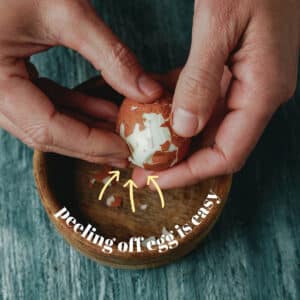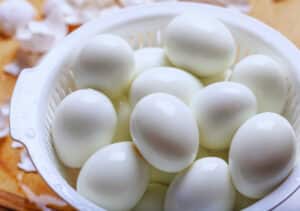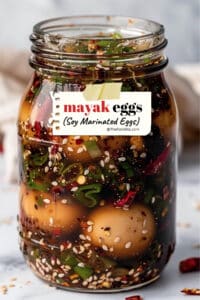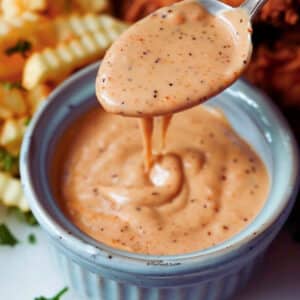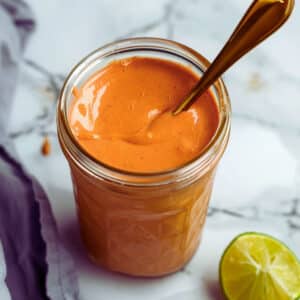Okay, I have to let you in on a secret: Mayak Eggs. Seriously, they're the best. Just imagine perfectly soft-boiled eggs soaked in this magical sweet and savory soy sauce marinade. They're a total flavor bomb! In Korea, Mayak Eggs are a go-to side dish or a quick breakfast, and once you try them, you'll get why. They're perfect for jazzing up a bowl of rice or adding instant oomph to your ramen. Ready to be obsessed?

Ingredients You'll Need
Marinade Ingredients:
- Coconut aminos (or soy sauce/tamari): This is your salty, savory backbone. Coconut aminos are a cool option if you're avoiding soy, but classic soy sauce or tamari work just as well.
- Dried Kelp (Kombu) and Radish stock: Okay, here's a little trick I use for my Mayak Egg marinade: a touch of dried kelp (or Kombu) and radish stock. Sounds a bit fancy, but it's super easy! The kelp gives the marinade this awesome depth of flavor – we're talking about serious umami. The radish adds a light, refreshing touch that brightens everything up.
- Water: Short on time or don't want to fuss with extra ingredients? Water works perfectly fine as your marinade base! You'll still end up with incredibly tasty eggs. For a balanced marinade, use a 1:1 ratio of soy sauce to water. This cuts the saltiness perfectly.
- Honey: This is key for that hit of sweetness that makes Mayak Eggs so addictive. Feel free to use sugar or another sweetener you like.
- Green onions: Fresh, bright flavor boost! Don't worry about chopping them super fancy – rough chunks are totally fine.
- Garlic: Because... garlic. Need I say more? Make sure you mince it up nice and small.
- Chili peppers: This is where you choose your own adventure! Red, green, or a mix! Adjust the amount to your spice tolerance. Leaving the seeds in packs a punch.
- Sea salt: Gives the marinade a little extra salty kick.
- Toasted sesame seeds: Okay, this adds a bit of crunch and that classic nutty, toasty flavor. You can toast them yourself in a dry pan for a few minutes for extra oomph!
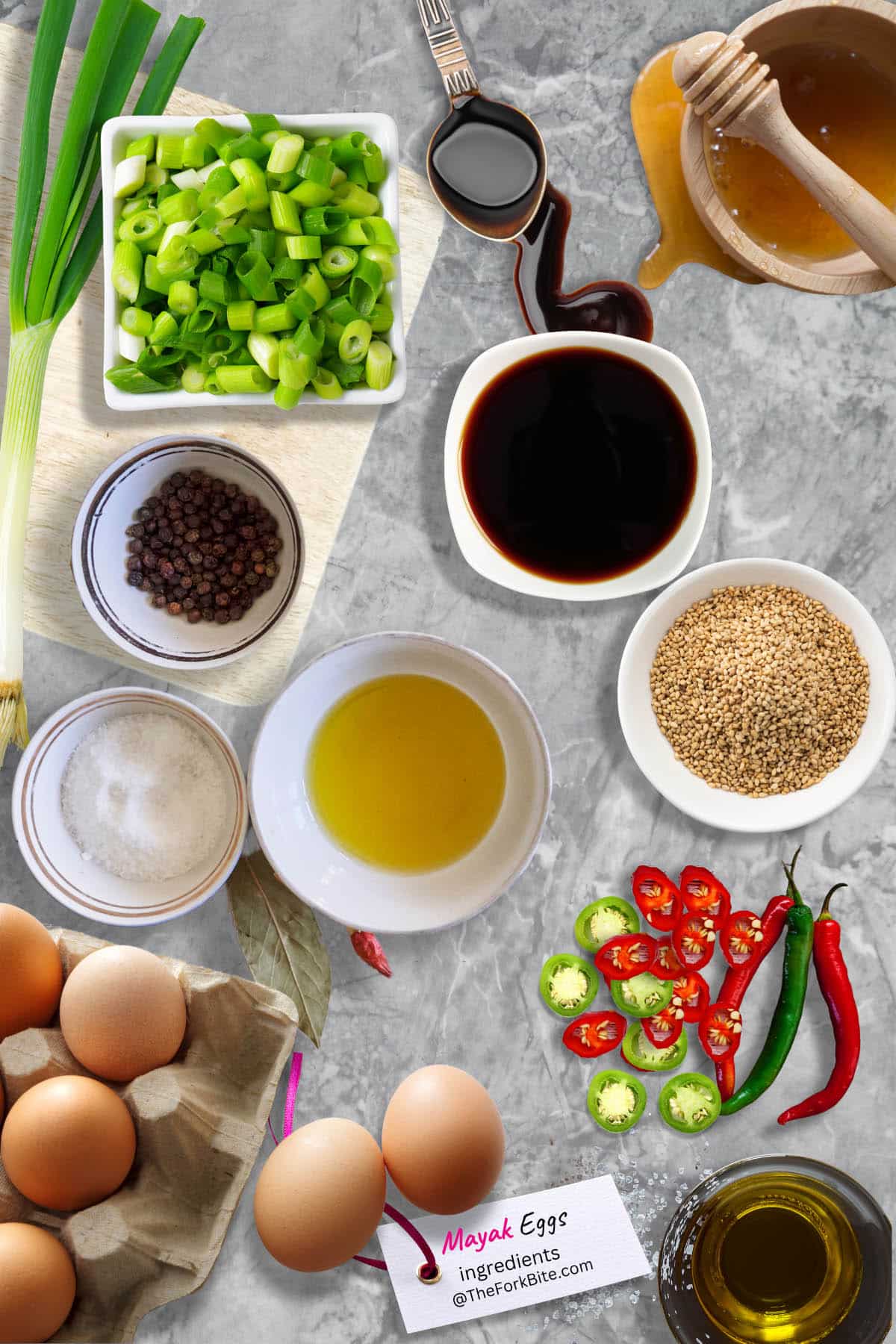
A Few Notes:
- Feel free to play around with proportions a bit once you get the hang of it. Like it sweeter? Add more honey!
- Don't have all the ingredients? Don't stress! A basic Mayak Egg can be made with just soy sauce, water, sugar, and garlic and still be delicious.
Step-by-step guide for Boiling Eggs
1 Gather Your Gear
- Eggs: Use fresh, room-temperature eggs for best results. Bringing your eggs to room temperature before cooking helps prevent cracking. Pull them out of the fridge 30 minutes before, or give them a quick soak in warm (not hot!) water for about 5 minutes.
- Pot: A medium-sized pot that allows your eggs to fit comfortably in a single layer.
- Water: Enough to fill the pot about halfway.
- Vinegar: A tablespoon of white vinegar (helps with peeling).
- Salt: A teaspoon of salt.
- Slotted Spoon: For gently lowering those precious eggs.
- Ice Bath: A bowl filled with ice water, your secret to easy peeling.
For an alternative method, you can also make delicious soft-boiled eggs in the air fryer. See our guide here for the Air fryer soft boiled eggs.
2 Get Your Water Boiling
- Fill your pot with enough water to cover the eggs in a single layer – crowding makes them cook unevenly. Turn the burner to medium-high heat and bring the water to a rolling boil – this means lots of big, active bubbles.
- Once the water reaches a rolling boil, stir in one tablespoon of vinegar and one teaspoon of salt. it helps the shell release more easily. Not essential, but worth a try! Lower the heat to a gentle simmer once your water reaches a boil.
- Center that Yolk (Optional): For perfectly centered yolks, gently stir the eggs in one direction for the first 30 seconds helps center the yolks. It's a pro chef trick, but your eggs will still be delicious without it!
This boiling method is also perfect for Chinese Tea Eggs (Cha Ye Dan) – check out our recipe for a delicious variation!

3 Add Your Eggs (Carefully!)
- Use your slotted spoon to gently lower the eggs into the simmering water one at a time.
- Avoid dropping the eggs in, as this can cause them to crack.
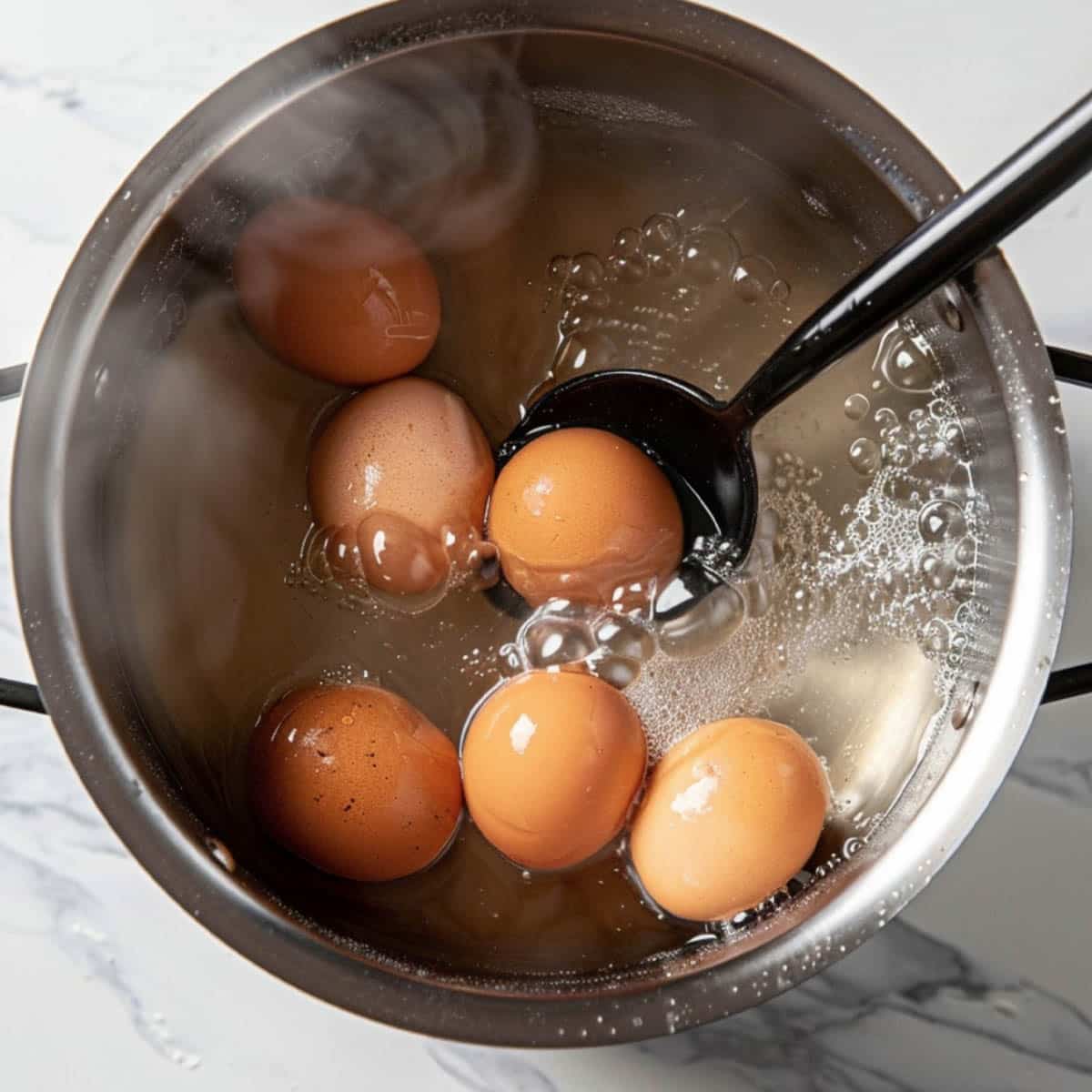
4 Set Your Timer
| Desired Yolk Texture | Boiling Time (From a Rolling Boil) |
|---|---|
| Very Runny Yolk | 5 minutes |
| Jammy, Soft-Set Yolk | 6 minutes |
| Slightly Firm Yolk | 7 minutes |
| Fully Set Yolk (Soft-boiled) | 8 minutes |
| Firm, Classic Hard-Boiled Yolk | 10-12 minutes |
- Soft-boiled (6 minutes): Perfect for jammy, liquid yolks.
- Slightly Firmer (7 minutes): A jammy yolk with a bit more set white.
- More Set (8 minutes): Yolk is still custardy but on the firmer side.
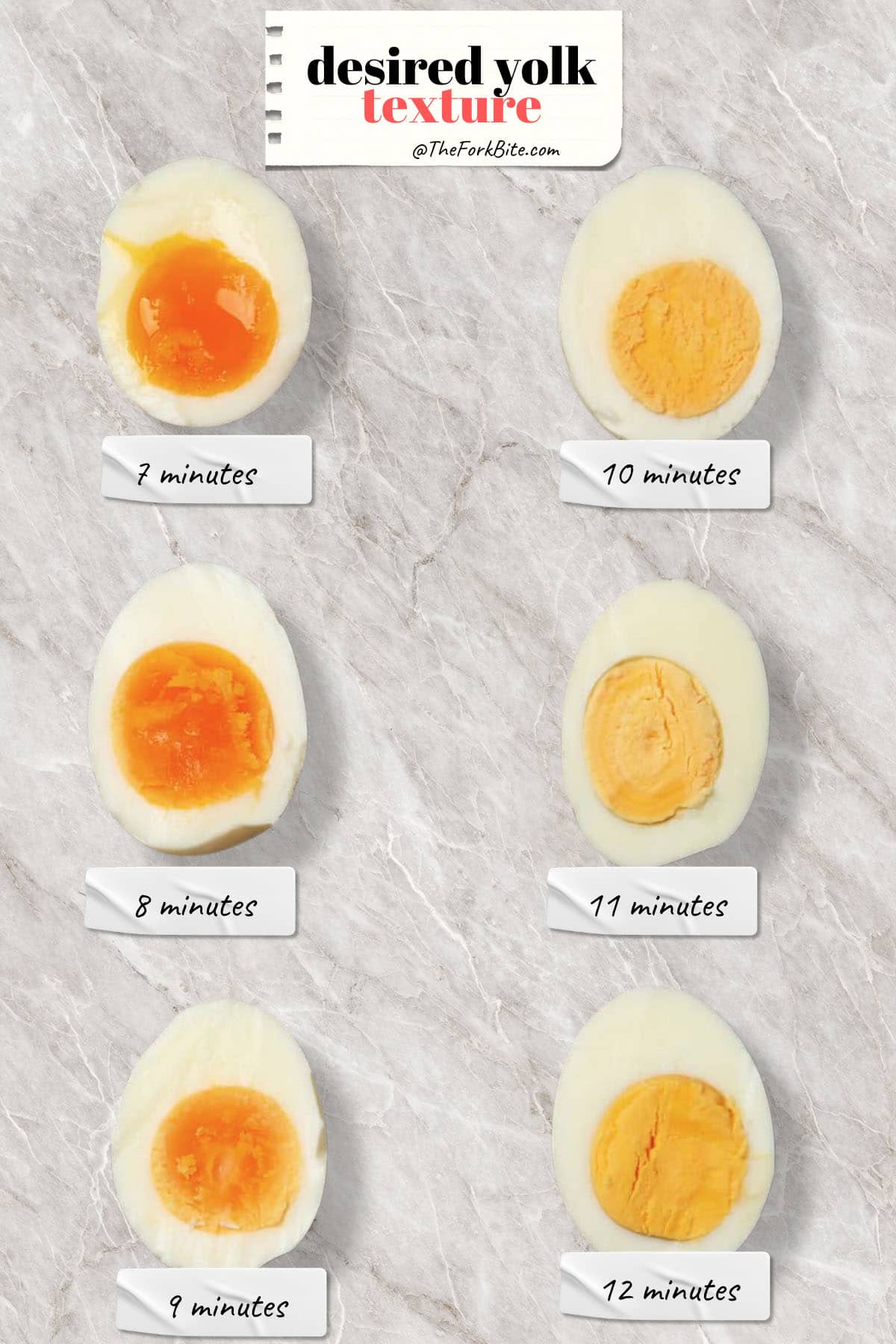
The ideal texture depends on your preference. For a deeper dive into soft-boiled and hard-boiled techniques, check out our guide here.
5 Ice Bath
- Once your timer goes off, immediately and carefully remove your eggs with the slotted spoon.
- Plunge them into the bowl of ice water for about 10 minutes. Don't skip this step! That sudden temperature change makes the egg contract away from the shell, making peeling a breeze.
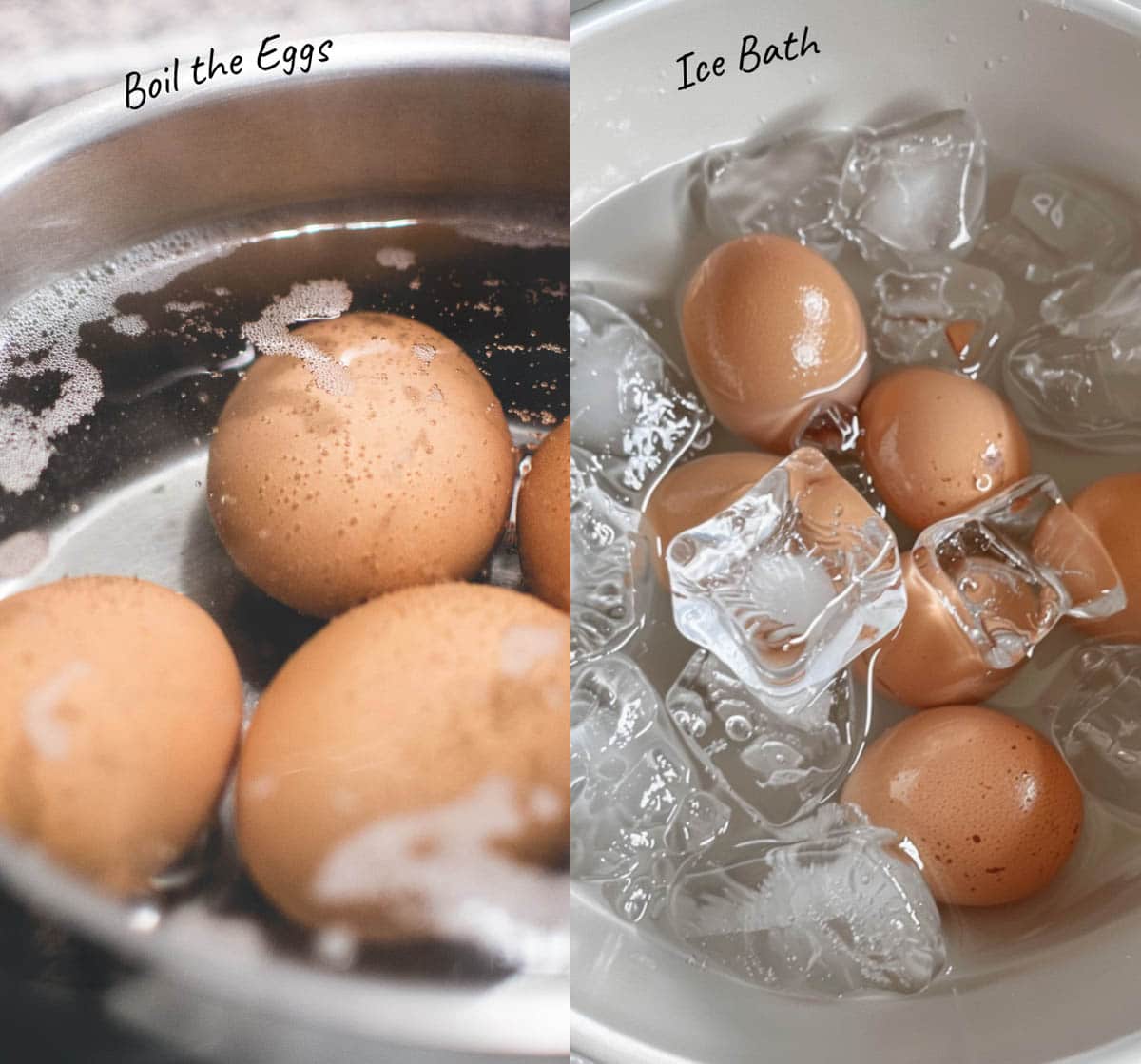
6 Time to Peel
- Peeling with Patience
- Tap and Roll: A gentle tap on the counter to crack the shell, followed by rolling the egg between your hands to loosen it all over.
- Underwater Action: Running water while you peel helps those stubborn shell bits slip right off.
- No Rush: Don't stress if a bit of egg white clings to the shell. A quick rinse and you're good to go!
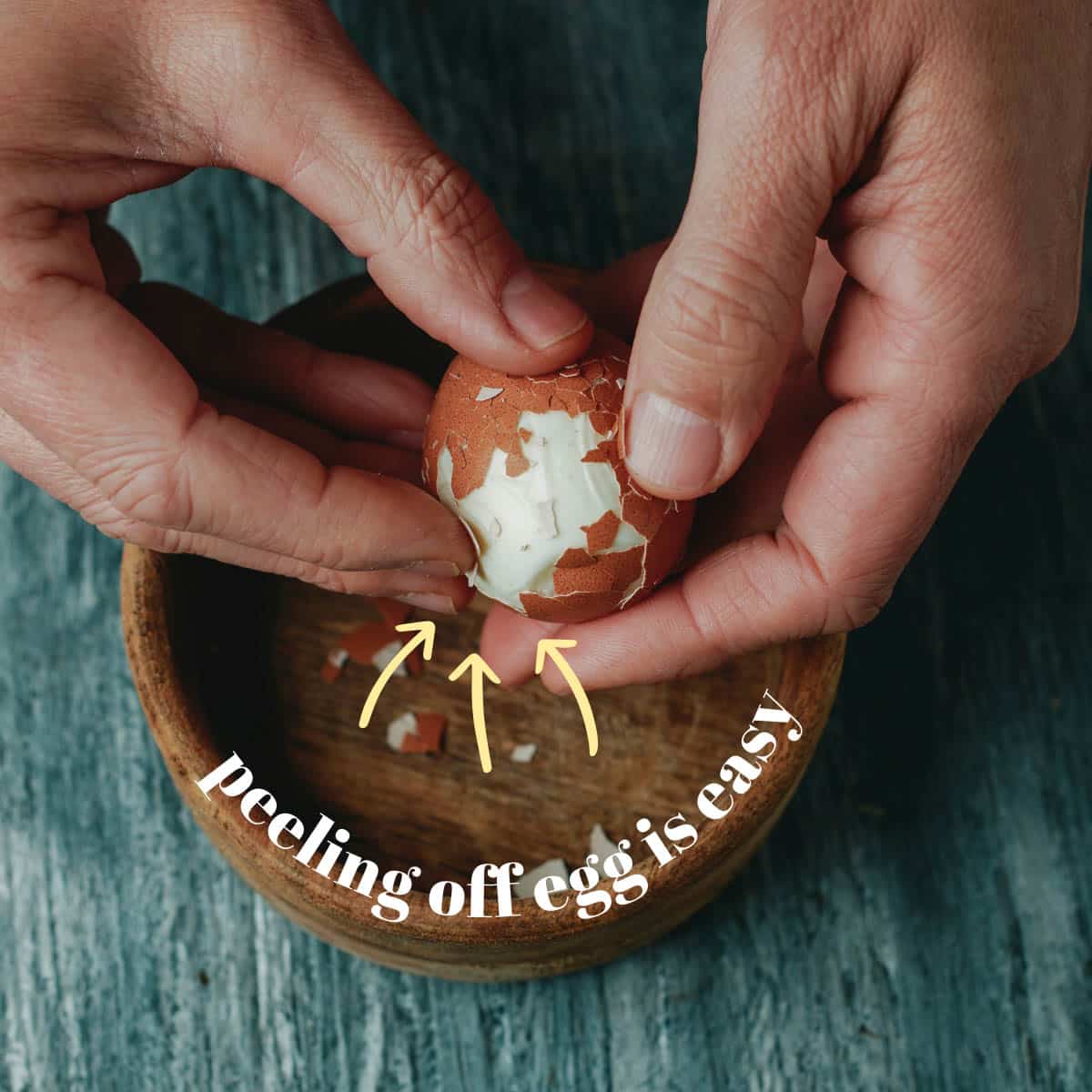
Perfectly cooked eggs are the foundation of delicious Mayak Eggs! You want jammy yolks or a classic hard-boiled texture – not undercooked whites. While you can technically reboil eggs, it can make them rubbery. For tips on perfect eggs every time and what to do if you accidentally undercook them, check out our guide here Can you reboil eggs? post.
How to Make Kelp and Radish Stock
What You'll Need:
- 4 cups Water
- 10 grams Dried Kelp (Kombu)
- 200 grams Daikon Radish
- Throw in some garlic cloves, onion and green onion (*optional)
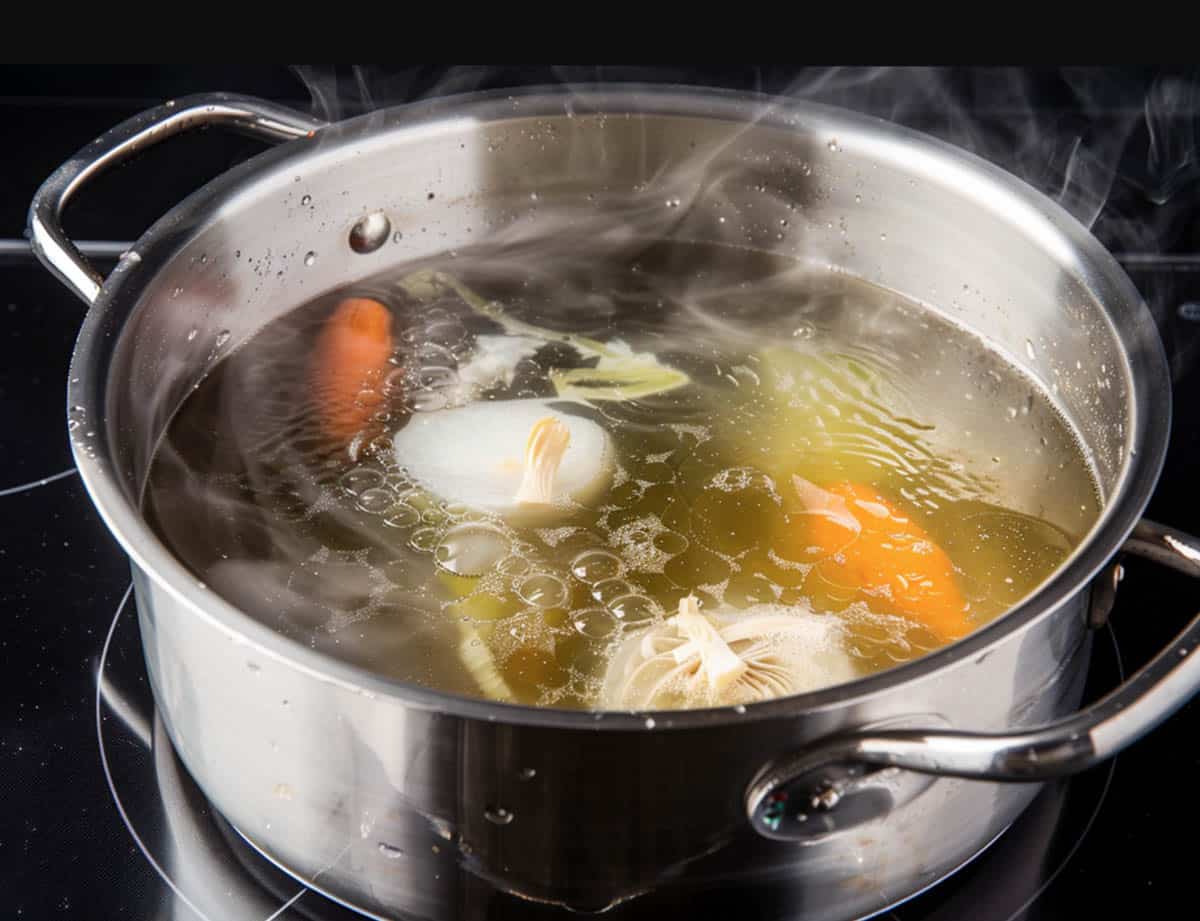
- Dried Kelp (Dasima/Kombu): A small piece goes a long way. You can find this in Asian grocery stores or online.
- Radish: Any kind works! Korean radish (mu) or daikon are traditional, but a regular red radish will do just fine.
- Water: Enough to comfortably cover your kelp and radish.
- Flavor Boost: For extra flavor, throw in a few garlic cloves, vegetables and onion along with the radish + kelp.
Let's Get Cooking (More Like Simmering)
- Prep Your Kelp: Give it a quick rinse to remove any dust. There's no need to soak it beforehand.
- Wash and Chop Your Radish: Scrub it well and cut it into large chunks – no need to be precise.
- Pot Power: Add your kelp, radish chunks, and enough water to cover them by an inch or so into a pot. For extra flavor, you can throw in some garlic, onion and vegetables (this is optional).
- Simmer Time: Bring the pot to a gentle simmer over medium-low heat. Let it simmer for about 20 minutes. You'll know it's ready when the radish is slightly softened and the water has a subtle golden hue.
- Strain and Cool: Remove the pot from the heat and carefully strain the stock. Discard the kelp and radish. Let your stock cool completely before using it in your Mayak Egg marinade.

Extra Tips:
- Storage: Your kelp and radish stock will keep in the refrigerator for a 3 to 4 days in an airtight container.
- Beyond Mayak Eggs: This stock is a great base for other Korean dishes like soups or stews!
How to Marinate Mayak Eggs
1 Gather Your Ingredients
- Peeled, cooked eggs: Your perfectly jammy eggs are ready for flavor!
- Marinade: Make sure you've whisked it together and given it a taste test to adjust it to your liking.
- Container: A jar, resealable container, or even a zip-top bag works. You just want something that seals and has enough room for the eggs to be completely submerged.

2 Start Marinating
- Gently place your peeled eggs into your chosen container. Handle them with a bit of care – they're still a little delicate!
- Pour your prepared marinade over the eggs until they're completely covered.
- Seal your container tightly.
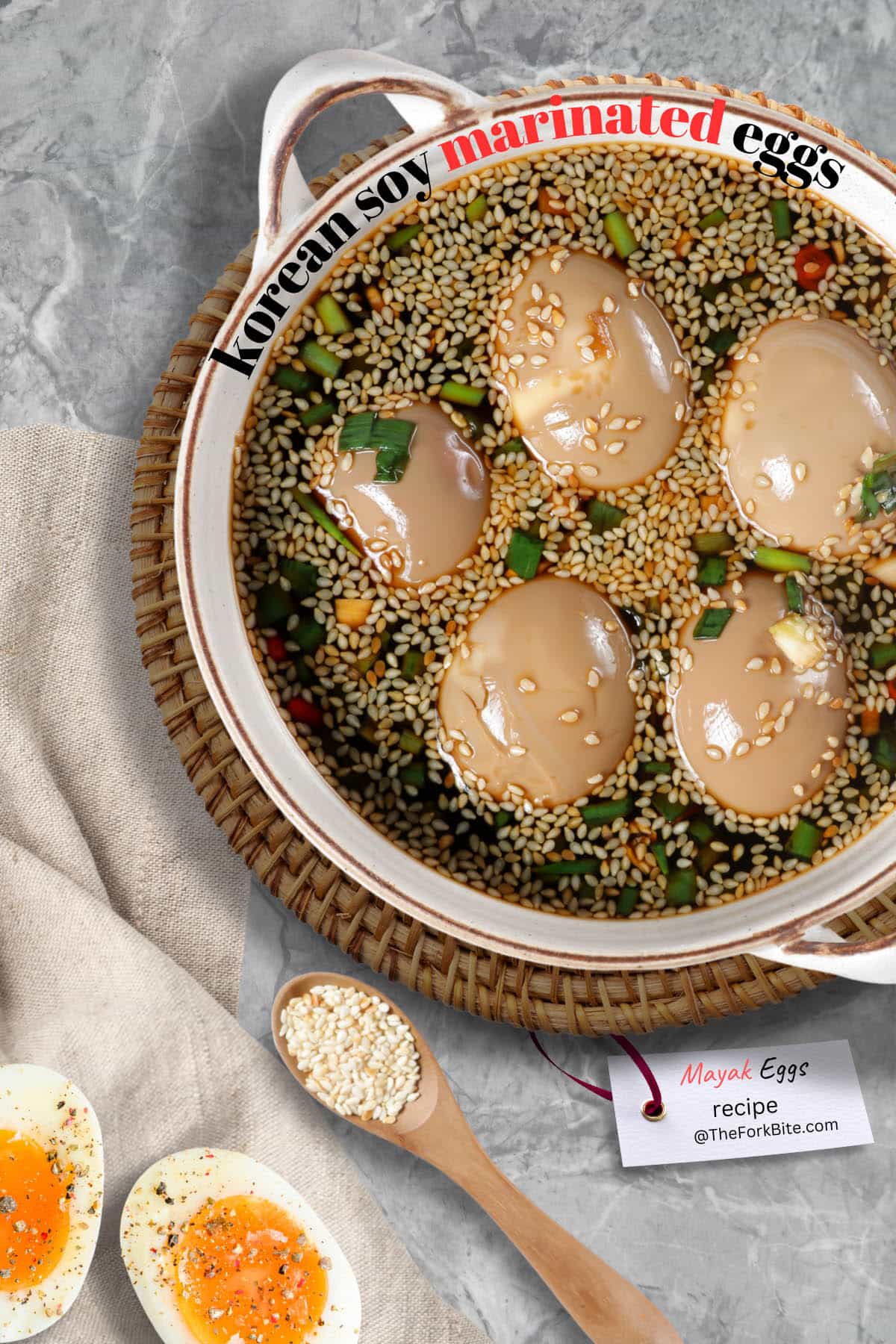
3 Chill & Infuse
- Pop your marinating eggs into the fridge.
- Give the container a gentle shake or swirl every so often to redistribute the marinade and make sure each egg is getting a good soak.
4 Patience is Key
- Minimum Time: At least a few hours will give the eggs a nice flavor boost.
- The Sweet Spot: Overnight marinating is ideal – that's when they become incredibly flavorful little gems.
- Maximum Marination: Generally, it's best to enjoy your Mayak Eggs within 3-4 days of marinating. The flavor will continue to intensify, but they can get a bit too salty if left for much longer.
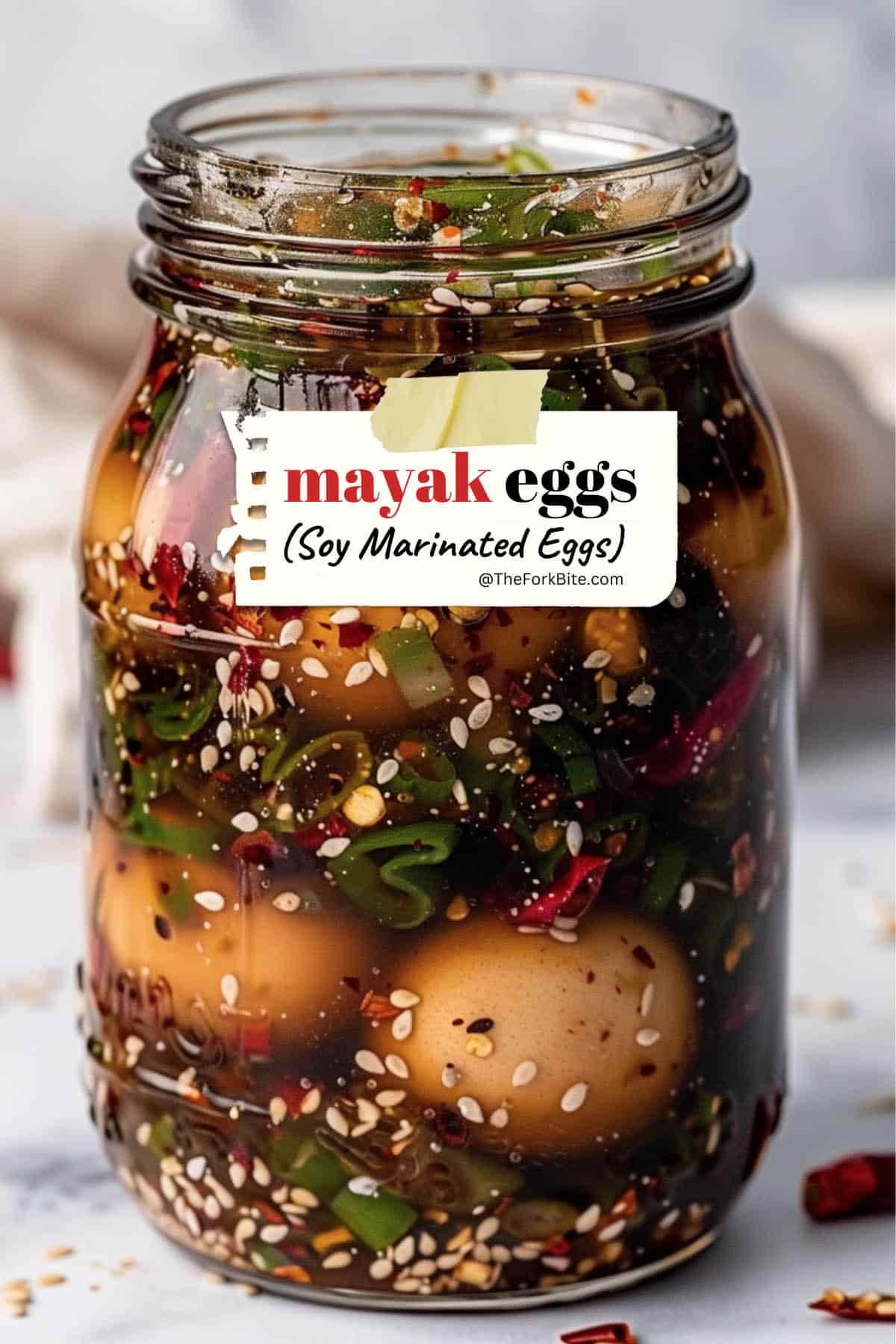
5 Time to Enjoy!
- Scoop those beautiful eggs out of the marinade, give them a quick shake to get rid of excess, and they're ready to devour!
Remember: The marinade is super flavorful too! Try drizzling a little extra over your fried rice or ramen noodles along with your Mayak Egg for an extra flavor punch.
Full Recipe
Mayak Eggs (Korean Soy Marinated Eggs) Recipe
Pin RecipeIngredients:
- 10 pieces Eggs
- 1 tablespoon vinegar (optional)
- 1 teaspoon salt (optional)
Kelp (or Kombu) & Radish Stock:
- 4 cups water
- 10 grams Kombu (or Dried Kelp)
- 200 grams Radish (or Daikon)
- 1 piece onion (optional)
- 3 cloves garlic (optional)
- 2 stalks scallions (optional)
Soy Sauce Marinade:
- 1 cup Kelp and radish stock (or sub with water)
- 1 cup soy sauce (or Tamari or coconut aminos for gluten-free)
- ½ cup honey (adjust the amount according to reference)
- 2 stalks scallions (chopped)
- 3 cloves garlic (minced)
- 1 piece red chili (sliced)
- 1 piece green chili (sliced)
For Garnish:
- 2 tbsp sesame oil
Instructions:
For Soft Boiled Eggs:
- For perfectly cooked Mayak Eggs, use room temperature eggs to prevent cracking. Let them sit out for 30 minutes or use a quick warm water soak (5 minutes).
- Fill the pot with enough water to cover the eggs in a single layer for even cooking. Heat over medium-high until you reach a rolling boil (lots of big bubbles).
- Once the water reaches a rolling boil, stir in one tablespoon of vinegar and one teaspoon of salt. it helps the shell release more easily. Not essential, but worth a try! Lower the heat to a gentle simmer once your water reaches a boil.
- Center that Yolk (Optional): For perfectly centered yolks, gently stir the eggs in one direction for the first 30 seconds helps center the yolks. It's a pro chef trick, but your eggs will still be delicious without it!
- Use your slotted spoon to gently lower the eggs into the boiling water one at a time.
- Set your timer:Soft-boiled (6 minutes): Perfect for jammy, liquid yolks.Slightly Firmer (7 minutes): A jammy yolk with a bit more set white.More Set (8 minutes): Yolk is still custardy but on the firmer side.
- Once your timer goes off, immediately and carefully remove your eggs with the slotted spoon.Plunge them into the bowl of ice water for about 10 minutes. Don't skip this step! That sudden temperature change makes the egg contract away from the shell, making peeling a breeze.
- Tap and Roll: A gentle tap on the counter to crack the shell, followed by rolling the egg between your hands to loosen it all over.Underwater Action: Running water while you peel helps those stubborn shell bits slip right off.
Kelp and Radish Stock:
- Prep Your Kelp: Give it a quick rinse to remove any dust. There's no need to soak it beforehand.Wash and Chop Your Radish: Scrub it well and cut it into large chunks – no need to be precise.
- Add your kelp, radish chunks, and enough water to cover them by an inch or so into a pot. For extra flavor, you can throw in some garlic, onion and vegetables (this is optional).
- Bring the pot to a gentle simmer over medium-low heat. Let it simmer for about 20 minutes. You'll know it's ready when the radish is slightly softened and the water has a subtle golden hue.
- Remove the pot from the heat and carefully strain the stock. Discard the kelp and radish. Let your stock cool completely before using it in your Mayak Egg marinade.
How to Make Mayak Eggs:
- Gently place your peeled eggs into your chosen container. Handle them with a bit of care – they're still a little delicate!
- Start the Marinade: Whisk together soy sauce, honey (or sugar), and kelp/radish stock until the honey or sugar dissolves completely.
- Flavor Boost: Stir in garlic, onion, scallion, red & green chilis, jalapeno (if using), and sesame seeds. Give it a taste and adjust the flavors as needed – want it spicier? Add a touch more chili!
- Marinate: Add your eggs to the marinade. Cover and seal your container tightly. Refrigerate for at least 2 hours, or up to 24 hours for maximum flavor.
- Give the container a gentle shake or swirl every so often to redistribute the marinade and make sure each egg is getting a good soak.
- Minimum Time: At least two hours will give the eggs a nice flavor boost.The Sweet Spot: Overnight marinating is ideal – that's when they become incredibly flavorful little gems.
Notes:
How to Store Your Mayak Eggs
For the best flavor and freshness, follow these tips:- Airtight is Key: Use an airtight container for both the eggs and their marinade. This keeps them fresh and prevents them from picking up other flavors in the fridge.
- Stay Cool: Always store your Mayak Eggs in the refrigerator at 40°F (4°C) or below.
- Marinade Matters: Make sure the eggs are fully covered by the marinade. This keeps them flavorful and prevents drying out.
- Safety First: Before eating, always give your eggs a quick check. If they look or smell off, it's safest to toss them.
How Long Do Mayak Eggs Last?
- In the Fridge: Marinated Mayak Eggs keep well in the refrigerator for 3-4 days in an airtight container. Keep in mind, the flavor will intensify and become saltier over time.
Can You Reuse the Marinade?
- Yes, with Limits: You can reuse the marinade for a few days. Add more eggs as you go, but be mindful of how long it's been used.
- Beyond Eggs: If you don't want to reuse it for more eggs, try adding the flavorful marinade to Korean pancakes or dumplings for an extra savory boost.
Serving Suggestions
-
- The Classic: Mayak Eggs are fantastic with freshly cooked rice! For extra deliciousness, drizzle a little leftover marinade and sesame oil over the fried rice. Perfect for a quick and satisfying meal.
- Ramen Upgrade: Since they're similar to Japanese ramen eggs, try them as a delicious topping for any noodle dish like miso soup ramen noodles!
Nutrition Information:
Please note that all nutrition information are just estimates. Values will vary among brands, so we encourage you to calculate these on your own for most accurate results.






